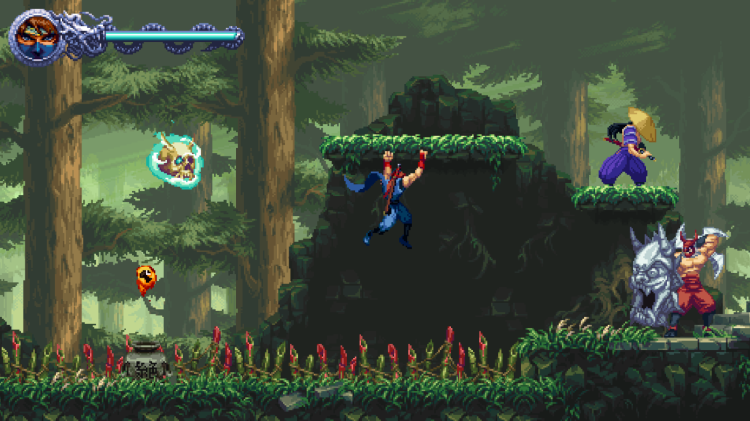Ninja Gaiden: Ragebound – Sharp Blades, Sharper Gameplay
Ninja Gaiden: Ragebound is a tough but fair action-platformer that captures the classic spirit of the series while introducing smart, fresh mechanics. It brings back the intense enemy gauntlets and precise platforming fans expect, but wraps them in new ideas that make every fight and jump feel exciting. The game has its flaws — some stages run too long, a few visual hazards are unclear, and it ends sooner than you’d like — yet it remains a polished, satisfying revival worth playing.
According to the GameSpot review, Ragebound feels like a title pulled from another era, reimagined by modern hands. Developed by The Game Kitchen, best known for Blasphemous, it wears its retro inspirations proudly.
The story isn’t the star here, and that’s fine. Instead of Ryu Hayabusa, you play as Kenji Mozu, a rookie from the Hayabusa Clan, and Kumori, a mysterious kunoichi from the rival Black Spider Clan. A sudden demon attack on Hayabusa Village forces the two into an uneasy alliance. From there, they journey through ancient villages, pirate coves, high-tech military sites, and more, all in a mission to stop a Demon Lord from being unleashed. The plot’s campy and a little nonsensical, but it works well as a framework for the constant action.
Our previous post, based on another Ninja Gaiden review from an influencer, was positive too! This latest entry cements the idea that Koei Tecmo’s current push for the franchise is heading in the right direction.

The two characters control differently enough to keep things fresh. Kenji is the traditional katana-wielding melee fighter, while Kumori fights at range with her kunai. Both share a fluid dodge roll, which can also be turned into a lunge attack, and they feel quick, agile, and responsive. The controls are tuned for precision, which is essential in a game where one wrong move can mean death.
What makes Ragebound stand out are its new mechanics layered over this familiar foundation. Hypercharge is the flashiest of these — defeat a special enemy or sacrifice some of your own health, and your next attack becomes a devastating strike capable of cutting down almost anything. Then there’s the Guillotine Boost, a spinning midair kick that lets you bounce off enemies or projectiles. It’s not just a combat move; the level design often forces you to chain boosts together to cross gaps or climb to higher areas, giving the platforming sections an extra kick.
Midway through, the story takes a twist when Kumori’s soul fuses with Kenji’s, giving him access to her abilities and unlocking Ragebound Arts. These are powerful special moves fueled by Rage Orbs, and they can be customized as you unlock more throughout the game. Choosing the right Art can make a tough boss fight much more manageable.
Even with the fusion, the game keeps switching control between the two characters. Demon Altar segments split them apart, requiring you to guide Kumori through timed, enemy-filled sections to unlock paths for Kenji. Her energy bar adds light pressure without being punishing — fail, and you can just retry without losing progress. It’s a clever change of pace that blends puzzle-solving with platforming.
Ragebound is challenging, but it plays fair. Enemies and traps are placed to test skill rather than frustrate, and checkpoints keep retries manageable. The game actively encourages mastery: hidden collectibles like golden scarabs act as currency for new talismans and Arts, while stage rankings push you to replay and improve. This is a game built for those who enjoy running the same level multiple times just to nail every jump, every attack, and every dodge.
The retro-inspired visuals are a highlight, with detailed pixel art that looks like a lost Super NES gem. The soundtrack matches the tone — fast-paced, dramatic, and perfectly fitting for slicing through demons at high speed. However, the visuals can occasionally be too busy, making it hard to tell a background object from a deadly hazard. The pacing isn’t flawless either; a few stages drag on, reusing enemy patterns to pad length, which makes them feel repetitive.
The adventure clocks in at under 30 stages, including optional missions, so it can be cleared faster than expected. Hidden items and a Hard mode unlocked after finishing the game add replay value, but if you’re expecting a sprawling epic, this isn’t it. On older hardware like Xbox One, there’s also occasional slowdown in busy scenes, though it doesn’t break the flow. Playing on a newer console smooths these issues out.
Despite its short runtime and minor rough spots, Ragebound nails what matters most — tight, rewarding gameplay. Every mechanic feels intentional, every move has weight, and the combination of classic Ninja Gaiden design with The Game Kitchen’s inventive touches makes it one of the most exciting revivals in years. Whether or not Ninja Gaiden 4 hits the same standard, this release shows there’s still plenty of life in the series.
Ninja Gaiden: Ragebound isn’t trying to reinvent the wheel. It’s a carefully sharpened blade — one that cuts clean, hits hard, and leaves just enough room for mastery. In the Year of the Ninja, this is the game that proves old-school action still has plenty to teach.

Comments